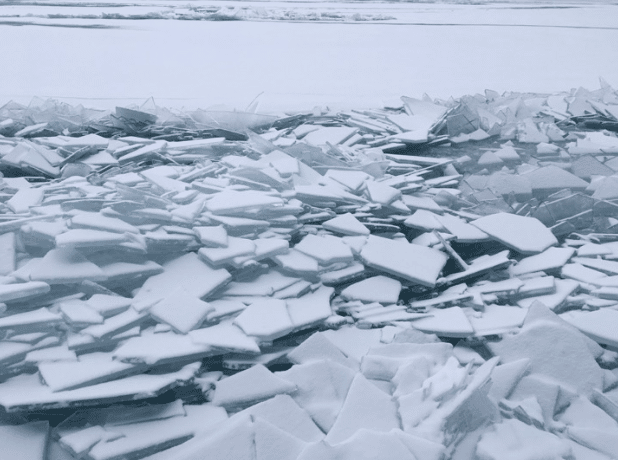Water Drawing: Rituals of Return
A Daily Pilgrimage for Sukkot guided by artist SaraNoa Mark and Dr. Akiva Sanders, Dan David Society of Fellows, Tel Aviv University.
Introduction
Water is life. Water is sustenance.
This pilgrimage has one location, the nearest accessible body of water to you. The pilgrimage uses the framework of time and repetition of returning daily to the water over the course of a week with repeated rituals to build and deepen a relationship with one place.
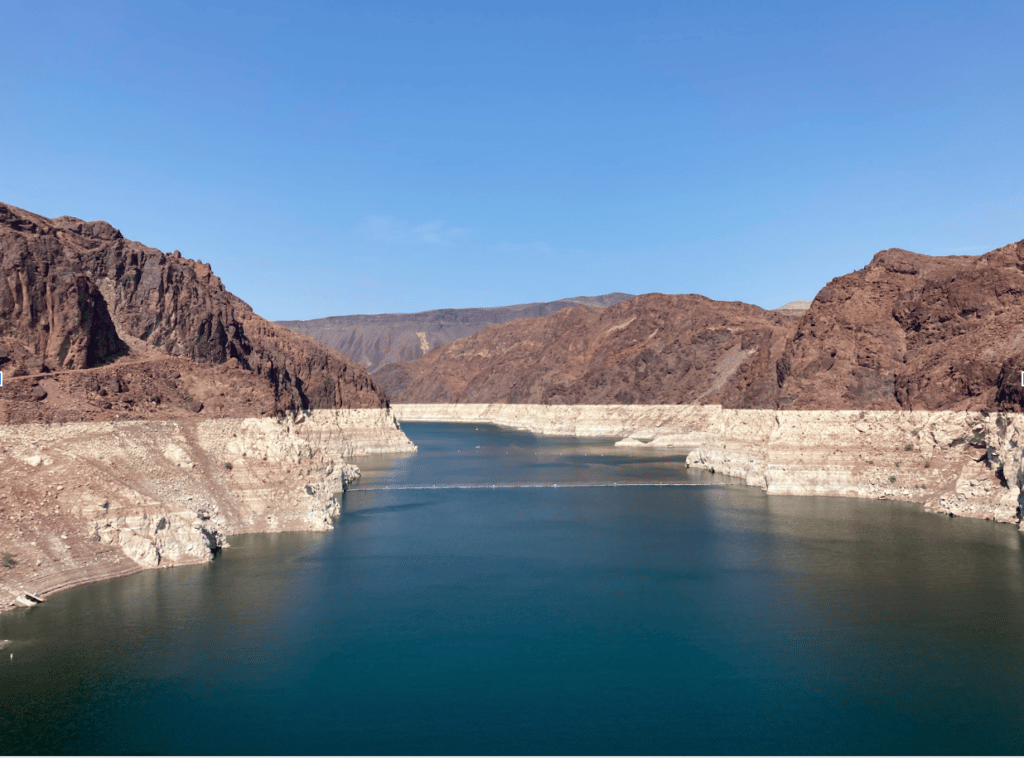
The Jewish holiday of Sukkot marks the changing of the year, the end of the agricultural season. It arrives just after the days of awe, days spent reciting, repenting, and reflecting on our behavior.
Shofar blown by Naomi Klionsky on a daily pilgrimage to Promontory Point, Lake Michigan:
With the piercing sound of the ram’s horn we are offered entry into a new spiritual year. In the Jewish calendar time is diligent yet mysterious, keeping track of simultaneous realms, with multiple new years. Sukkot arrives when we are renewed spiritually. Free of our errors of the last year, our prayers carry extra power. The first thing we do: we pray for rain. According to the Jewish tradition, just as our names are inscribed in the book of life on Yom Kippur, Sukkot is when the world is judged for rain. The agricultural holiday contains numerous water rituals: We wave four species of water-dependent plants in daily prayer and as a congregation we perform Hoshanot where we chant as we follow a circular procession with the species held high.
Recording of Hoshanot read in the community of Turkish Jews in Seattle:
In antiquity, Sukkot was one of three festivals during which Judeans would undertake a mass pilgrimage to the hill of Moriah in the Holy city of Jerusalem. On Sukkot, pilgrims watched the yearly water libations that were performed in the temple on the hill. The ritual is known as “Simchat Beit Hashoevah” translated roughly to Rejoicing at the Place of the Water Drawing. In order to induce rain in the coming year, the priest poured out collected rain water from the previous season. This ritual took place every day of the holiday except the sabbath. The priest would carry a golden flask with water from the rock-cut pool of Silwan that is fed from the Gihon Spring on a journey along the Jerusalem pilgrimage road, the same road that held pilgrims coming from throughout the surrounding region. He would then pass through the Water Gate that led to the temple. The Talmud writes: “one who had never witnessed the Rejoicing at the Place of the Water Drawing had never seen true joy.” The festivity is described with the lighting of incense, orchestras of lutes, trumpets, harps, and cymbals and numerous candles.
Finally, at the very end of the holiday, the annual prayer for rain is recited. Upon its completion we recite an abbreviated prayer for rain three times a day until Passover when we begin to pray for dew.
אַף בְּרִי אֻתַּת שֵׁם שר מָטָר. Af-Bri is the designated name of the rain angel,
לְהַעֲבִיב וּלְהַעֲנִין לְהָרִיק וּלְהַמְטַר. who overcasts [the sky], and makes clouds, to empty them and cause rain to fall.
מַיִם אִבִּים בָּם גֵּיא לַעֲטַר. Water with currents with which to adorn the valley;.
לְבַל יוּעֲצָרוּ בְּנִשְׁיון שְׁטַר. let it not be withheld because of [our] unpaid debts.
אֱמוּנִים גְּנון בָּם שׁואֲלֵי מָטָר: Let [the merit of] the faithful shield those who pray for rain.
יַטְרִיחַ לְפַלֵּג מִפֶּלֶג גֶּשֶׁם. He will impose [upon Af-Bri] to divert rain from streams of water;
לְמוגֵג פְּנֵי נֶשִׁי בְּצַחות לֶשֶׁם. to soften the surface of the earth with sparkling, gem-like drops.
מַיִם לְאַדְרָךְ כִּנִּיתָ בְּרֶשֶׁם. Water [symbolizes] Your might, as You labeled it in Scripture.
לְהַרְגִיעַ בְּרַעֲפָם לִנְפוּחֵי נֶשֶׁם. It reassures, with its drops, those in whom was blown the breath [of life],
לְהַחֲיות מַזְכִּירִים גְּבוּרות הַגָּשֶׁם: to keep alive those who mention the powers of rain.
אֱלהֵינוּ וֵאלהֵי אֲבותֵינוּ: Our God and God of our Ancestors!
זְכור אָב נִמְשַׁךְ אַחֲרֶיךָ כַּמַּיִם. Remember the ancestor who was drawn to You like water.
בֵּרַכְתּו כְּעֵץ שָׁתוּל עַל פַּלְגֵי מַיִם. You blessed him like a tree planted beside streams of water.
גְּנַנְתּו הִצַּלְתּו מֵאֵשׁ וּמִמַּיִם. You protected him, You rescued him from fire and from water;
דְּרַשְׁתּו בְּזָרְעו עַל כָּל מָיִם: You sought him out when he sowed beside all waters.
בַּעֲבוּרו אַל תִּמְנַע מָיִם: For his sake, do not withhold water.
זְכור טָעַן מַקְלו וְעָבַר יַרְדֵּן מַיִם Remember the one who, carrying his staff, crossed the Jordan’s water.
יִחַד לֵב וְגָל אֶבֶן מִפִּי בְאֵר מַיִם He was single-hearted,
כְּנֶאֱבַק לו שר בָּלוּל מֵאֵשׁ וּמִמַּיִם When he was attacked by an angel comprised of fire and water,
לָכֵן הִבְטַחְתּו הֱיות עִמּו בָּאֵשׁ וּבַמָּיִם. You promised to be with him through fire and through water.
בַּעֲבוּרו אַל תִּמְנַע מָיִם. For his sake, do not withhold water.
זְכור מָשׁוּי בְּתֵיבַת גּומֶא מִן הַמַּיִם Remember the one who was drawn out, in a reed basket, from the water.
נָמוּ דָלה דָלָה וְהִשְׁקָה צאן מַיִם [About whom] they said, “He drew water and watered the sheep.”
סְגוּלֶיךָ עֵת צָמְאוּ לְמַּיִם When Your treasured ones, thirsted for water,
עַל הַסֶּלַע הָךְ וַיֵּצְאוּ מָיִם. he struck the rock and water gushed out.
בְּצִדְקו חון חַשְׁרַת מָיִם. In [the merit of] his righteousness grant us abundant water.
זְכור שְׁנֵים עָשר שְׁבָטִים שֶׁהֶעֱבַרְתָּ בְּגִזְרַת מַיִם Remember the twelve tribes, whom You brought through the divided waters;
שֶׁהִמְתַּקְתָּ לָמו מְרִירוּת מַיִם for whom You sweetened the bitterness of water.
תּולְדותָם נִשְׁפַּךְ דָּמָם עָלֶיךָ כַּמַּיִם Their descendants, their blood was spilled for Your sake like water.
תֵּפֶן כִּי נַפְשֵׁנוּ אָפְפוּ מָיִם. Turn, for our soul is engulfed like water.
בְּצִדְקָם חון חַשְׁרַת מָיִם: In their righteousness grant us abundant water.
שָׁאַתָּה הוּא ה’ אֱלהֵינוּ מַשִּׁיב הָרוּחַ וּמורִיד הַגֶשֶׁם You Lord, our God, are Causer of the wind to blow and of the rain to fall
לִבְרָכָה וְלא לִקְלָלָה. אמן: For blessing and not for curse. Amen
לְחַיִּים וְלא לַמָּוֶת. אמן: For life and not for death. Amen
לְשובַע וְלא לְרָזון. אמן: For plenty and not for scarcity. Amen
-Eleazar ben Kalir, Prayer for Rain
The intimate relationship between survival and the availability of natural water was omnipresent in the ancient world. Human settlements of any size were always built along watercourses and it was in these places that what we know of as civilization came into being. Over the past two centuries, an increasing proportion of the world’s populations is no longer directly involved in agriculture. We are presented with a façade of human control of water: streams and rivers are dammed and diverted, settlements are built along highways rather than bodies of water, and water is sold in bottles at every convenience store. But even if many are personally detached from working the land themselves, this entire system is built on a foundation of continuous yearly rainfall. It is in the most recent years when this relationship has once again become more apparent: Water-rationing regimes have become more common around the world, as have shortages and forest fires.
While undertaking a pilgrimage, this dependence on natural water sources is thrown into high relief. A person can only carry so much water with them at one time, and must plan the route in order to replenish this supply every couple days. When passing along these water routes, a traveler encounters the communities that are dependent on this water. It is there that they are offered hospitality and conversation. In order to carry this water supply, the pilgrim needs a flask. In fact, this use has created its own category of vessel form in many places and times.
Choose a Pilgrim Flask:
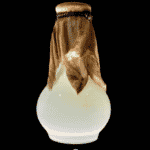
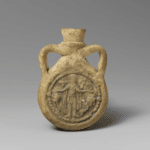
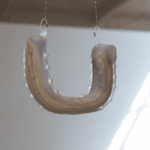
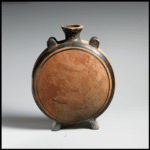
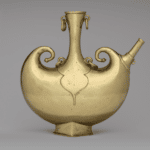
It is with this that we begin our pilgrimage, choosing a water flask, to collect water to carry as we walk. Find a vessel in your home. If you are engaging this route as a pilgrimage-in-place you can draw one of the pilgrim flasks, or invent your own pilgrim flask.
Transporting water on a pilgrimage is so central that the water carried often takes on a meaning of its own. Water sources around the world, particularly springs, have themselves become the destination of pilgrimage routes, and pilgrims collect water not only for sustenance but in order to keep the holiness of the journey with them once they have returned.
Long-distance journeys to water sources are important to many pilgrims. Embarking on a pilgrimage takes the traveler out of their daily surroundings and forces them to become a stranger who relies on acts of kindness and to rely on acts of kindness.
A journey taken repeatedly to a nearby body of water is a different type of pilgrimage. The relationship that can be cultivated between the pilgrim and the body of water can, in this way, deepen over the course of months and years. It was this kind of repetition that characterized the relationship between the ancient Judeans and the Gihon spring and the hill of Moriah.
Supplies:
Pilgrim flask, pencil, notebook, trowel or any utensil from which you can draw a line, audio recording device.
Rituals for Repetition
The Journey

For our pilgrimage we will focus on this concept of repetition. Rather than using distance as measurement, we will use time and the succession of movement throughout the week to mark our pilgrimage route.
As a part of this pilgrimage we will return to a body of water daily for a week, mirroring the week-long festival of Sukkot, deepening our relationship with this place through repeated rituals.
Think about where you live. What is the closest body of water to you? Was proximity to water part of your decision in choosing a place to live? How do you travel to the water? What makes this body of water worthy of pilgrimage?
If you are engaging this route as a pilgrimage-in-place: Use Google Street View to follow a path to a body of water.
Carrying your flask, begin the journey to the body of water. Observe your route. Does it move along a populated area or is it set off from the settlement? Who else is making this journey? What time of day have you chosen to depart? Do you have a reason for beginning this journey? Look at the color of the sky. Guess the color of the water.
The Libation
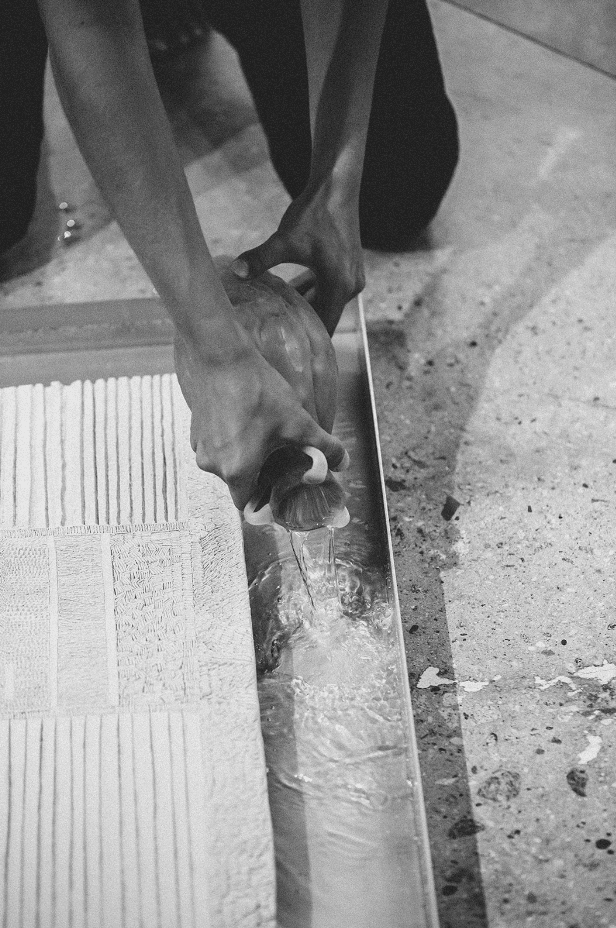
From the second day of your pilgrimage and onward begin each day’s rituals by returning the water in your flask to its source. Pray for rain. Consider the water’s journey away and towards its source as you went towards and away from your home. Think about places facing drought and places managing floods as you return your collected water to its source.
Observe
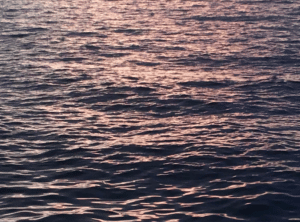
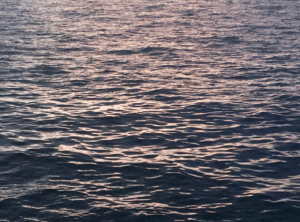
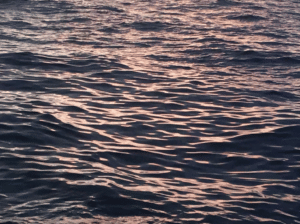
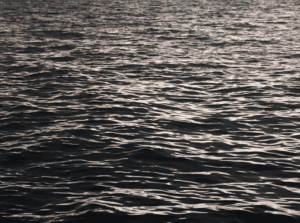
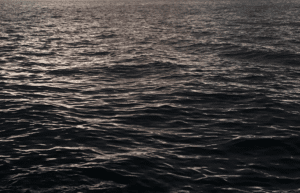
Observe the water: Does it sway? Does it speed up? Is it still? Is there a direction the water is traveling? What is the distance between you and the water? Do you desire to be close to the water? Can you immerse yourself in the water? Can you drink the water? Is your view endless? Does the water feel vast? Contained? Does the water mark a boundary? Is it being used for agriculture, transportation or another purpose? Does the water dictate the pace of your breath? Notice its color, the light on the water’s surface. Notice the water against the sky. Has the color of the water shifted? What is the farthest visible thing from you? Can you reach it? What thought keeps returning to you?
Listen
What people and other species are making this water their home? How do they interact with the place? Can you find quiet? How do you define quiet? Does the water gargle? Does the water speak? Does the water filter through rocks, slither over leaves? Listen. Record the sounds of the place.
Hear what you hear, feel what you feel. That is how you will do your best work. Whether setting up underwater or on land, do it quickly and intuitively, avoiding critical thoughts at first–just follow your feelings towards your next optimal recording. As you feel, draw your attention to the background first, then move closer. You’ll also want to identify the faintest sound you can hear. Now’s the time to get critical: is it smooth or gritty. If gritty, it could be time for fresh batteries even though your battery indicator shows sufficient voltage.
I dutifully listen not only to the delicate sounds of nature but also the faint evidence of distant noise pollution.
For example, I was recently considering a return visit to Washington’s Pipestone Canyon. This was one of my favorite listening/recording places during the early 80’s when I was first learning the art of field recording. There was one Western Meadowlark in particular that I had come to know over a two-year period by making repeated camping trips from Seattle. I would wake in the morning after sleeping on the ground and setup next to a sagebrush bush where I had watched him and heard him sing his hardest the evening before. The rock wall behind him was highly reflective and the rolling hills that surrounded the Canyon added ripples to his song’s echo. As he rotated his position on the uppermost branch, singing brightly, the reflected sound imaged the constantly changing acoustic environment much like a radar signal reveals land in a fog: quick and bright when facing the cliff walls, then delayed and resounding when facing down Canyon. I’d been thinking of attempting another recording there with some recently purchased equipment. But an up-to-date Google view informs me that a wildfire has recently devastated the area, erasing the concert my remaining lifespan. Thus, I saved myself an unnecessary trip.
It is with this reverence for life that you should silently enter nature’s cathedral, and, if you will, worship—the truest form of listening.
Listen to the pattering of rain, distinctly tapping each leaf, it allows a nice visualization for the audience of the plants close by. The contrast provided by brief drops and long flowing birdsong may also be stunning, especially when the drops progress to include drips.
Listen. Memorize the sound. Take your time—as long as five minutes. Notice that what initially might sound like “just white noise” soon becomes an elaborate braiding of individual streamlets. The more you listen, the more you learn.
-Gordon Hempton
Gihon Spring Recording, Jerusalem 2022
Trace
The pond rises and falls, but whether regularly or not, and within what period, nobody knows, though, as usual, many pretend to know. It is commonly higher in the winter and lower in the summer, though not corresponding to the general wet and dryness. I can remember when it was a foot or two lower, and also when it was at least five feet higher, than when I lived by it. There is a narrow sand-bar running into it, with very deep water on one side, on which I helped boil a kettle of chowder, some six rods from the main shore, about the year 1824, which it has not been possible to do for twenty-five years; and on the other hand, my friends used to listen with incredulity when I told them, that a few years later I was accustomed to fish from a boat in a secluded cove in the woods, fifteen rods from the only shore they knew, which place was long since converted into a meadow. But the pond has risen steadily for two years, and now, in the summer of ’52, is just five feet higher than when I lived there, or as high as it was thirty years ago, and fishing goes on again in the meadow. This makes a difference of level, at the outside, of six or seven feet; and yet the water shed by the surrounding hills is insignificant in amount, and this overflow must be referred to causes which affect the deep springs. This same summer the pond has begun to fall again. It is remarkable that this fluctuation, whether periodical or not, appears thus to require many years for its accomplishment. I have observed one rise and a part of two falls, and I expect that a dozen or fifteen years hence the water will again be as low as I have ever known it. Flint’s Pond, a mile eastward, allowing for the disturbance occasioned by its inlets and outlets, and the smaller intermediate ponds also, sympathize with Walden, and recently attained their greatest height at the same time with the latter. The same is true, as far as my observation goes, of White Pond.
-Henry David Thoreau, Walden
Trace the surface of the water on the shore with your pencil or trowel. Does the level change moment by moment, day by day? Where did this water come from and where is going? It is not only you making a journey to the water, the water has also come on a journey to meet you there. When and how did the water start gathering in this place (melting ice, rainfall, dam construction)?
If you are engaging this route as a pilgrimage-in-place: Monitor the level of the body of water here.
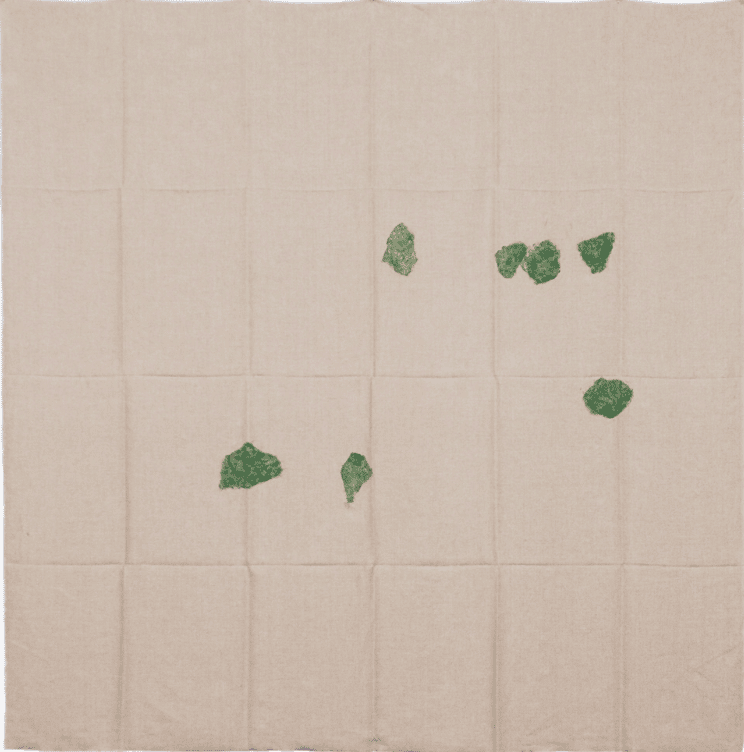
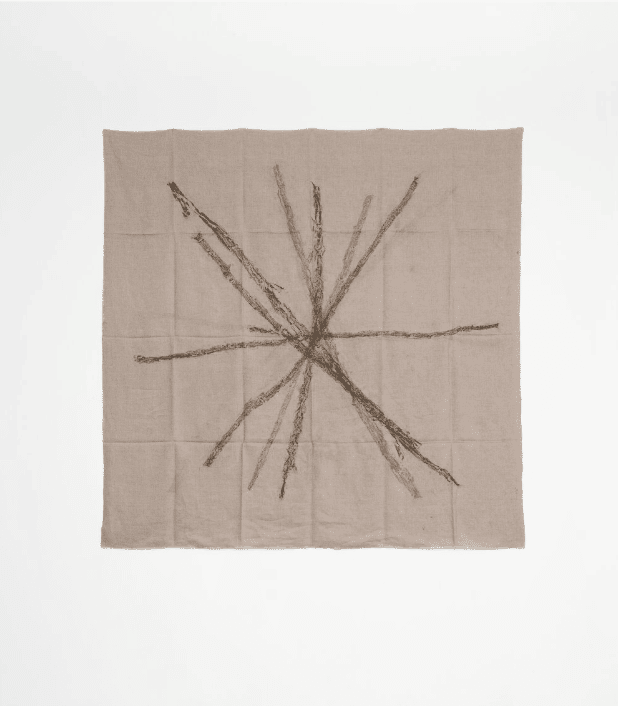
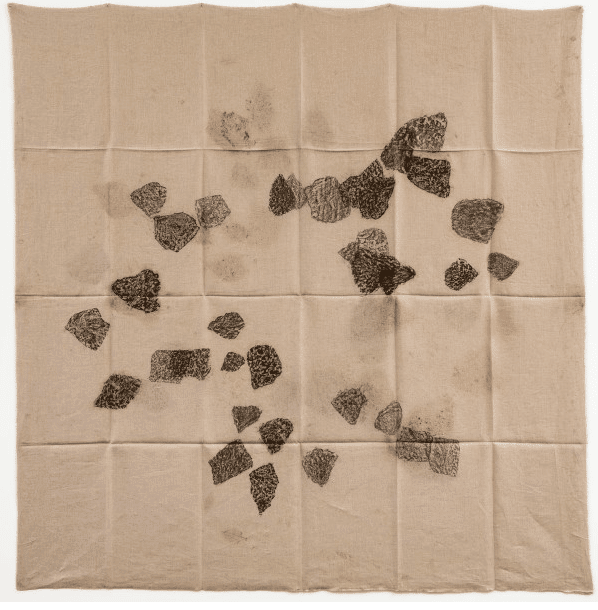
Draw Water
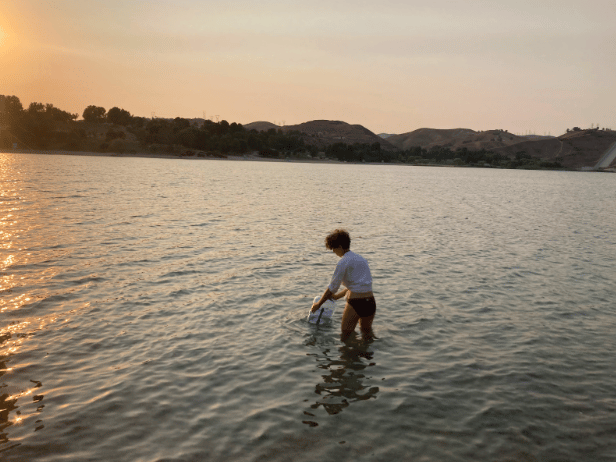
Bring the flask to the edge of the water, fill up the flask.
How does it feel to collect the water? To return with a portion of your pilgrimage in hand? What does it mean to carry an experience? What becomes of the water removed from its location?
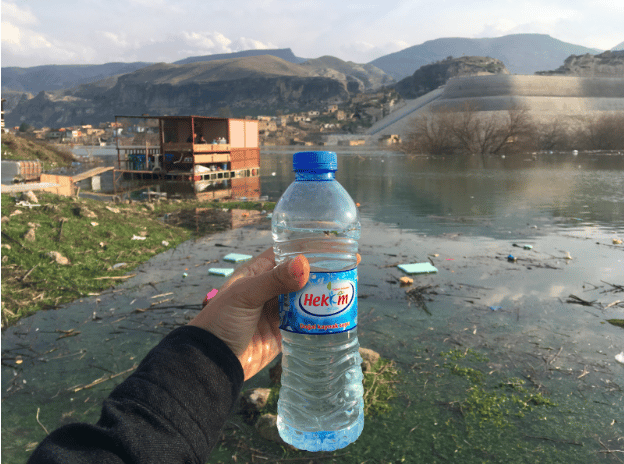
There is a person who collects sand. This person travels the world and—on arrival at a sea-shore, the banks of a river or lake, or a desert, or wasteland—gathers a handful of sand and takes it away. On returning home, thousands of little jars are waiting, lined up on long shelves: inside them the fine grey sand of Lake Balaton, the brilliant white particles from the Gulf of Siam, the red shingle that the Gambia river deposits on its course down through Senegal, all display their not particularly vast array of nuanced colours, revealing a uniformity like the moon’s surface, despite the differences in granulosity and consistency, from the black and white sand of the Caspian Sea, which seems to be still bathed in salt water, to the tiniest pebbles from Maratea, which are also black and white, to the fine white powder speckled with purple shells from Turtle Bay, near Malindi in Kenya. …
One has the feeling that this set of samples from the universal Waste Land is on the point of revealing something important to us: a description of the world? The collector’s secret diary? An oracular response to myself as I scrutinize these motionless sand-clocks and reflect on the moment I have reached in my life? Maybe all of these things together. The collection of sands that have been selected chronicles what remains of the world from the long erosions that have taken place, and that sandy residue is both the ultimate substance of the world and the negation of its luxuriant and multiform appearance. All the scenarios of the collector’s life appear more alive here than if they were in a series of colour slides. In fact, one would think that this sounds like a life of eternal tourism (and that is just the way that life appears in any case in colour slides, and it is how posterity would reconstruct it if it were only slides that remained to document our times): basking on exotic beaches is alternated with more arduous explorations, in a geographic restlessness that betrays a sense of uncertainty, of anxiety. …
At this point there is nothing left to do except to give up, walk away from the case, from this cemetery of landscapes reduced to a desert, this cemetery of deserts on which the wind no longer blows. And yet, the person who has had the persistence to continue this collection for years knew what she was doing, knew where she was trying to get to: perhaps this was her precise aim, to remove from herself the distorting, aggressive sensations, the confused wind of being, and to have at last for herself the sandy substance of all things, to touch the flinty structure of existence. That is why she does not take her eyes off those sands, her gaze penetrates one of the phials, she burrows into it, identifies with it, extracts the myriads of pieces of information that are packed into a little pile of sand. Each bit of grey, once it has been deconstructed into its light and dark, shiny and opaque, spherical, polyhedral and flat granules, is no longer seen as a grey or only at that point begins to let you understand the meaning of grey.
So, deciphering the diary of the melancholic (or happy?) collector, I have finally come round to asking myself what is expressed in that sand of written words which I have strung together throughout my life, that sand that now seems to me to be so far away from the beaches and deserts of living. Perhaps by staring at the sand as sand, words as words, we can come close to understanding how and to what extent the world that has been ground down and eroded can still find in sand a foundation and model.
-Italio Calvino, Collection of Sand
Reflecting
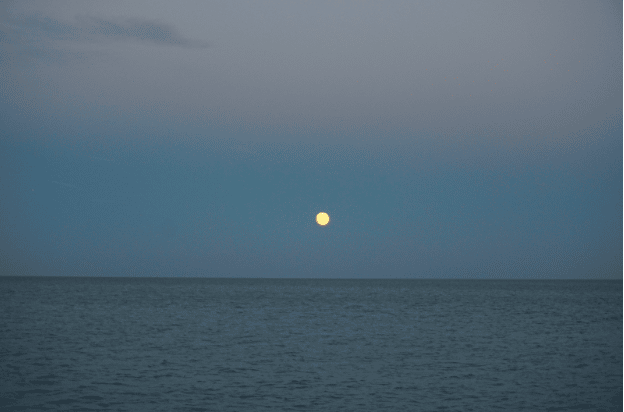
As you make the journey home, reflect on what you gathered from this journey. Envision the water, what do you recall? Does it resemble the water you collected? Do you feel a stronger connection to the place through your memory or through the water in hand? Do you feel pulled to return? Can you find the water on a map? Does the image on the map resemble the place in which you stood?
Reflection
“I talked about places, about the ways that we often talk about love of place, by which we mean our love for places, but seldom of how the places love us back, of what they give us. They give us continuity, something to return to, and offer a familiarity that allows some portion of our lives to remain connected and coherent… And distant places give us refuge in territories where our own histories aren’t so deeply entrenched and we can imagine other stories, other selves, or just drink up quiet and respite.”
― Rebecca Solnit, The Faraway Nearby
How is returning to a place unique from arriving for the first time? What does it mean to return to a place? Impacted by our experience can we ever truly return? As you continue to return to the water do you find yourself taking the same route each day? What do you notice upon return that you could not notice on your first visit? Have your motivations for the journey shifted? Do you see others returning from day to day? Does anyone recognize your return? Do you feel a connection with the people drawn to the water? What here holds your attention? Did what held your attention yesterday capture your attention today? What kind of relationship are you building with the water? Does this relationship involve care, protectiveness, gratitude, awe? Do you feel you need something from the water? Do you feel the water needs something from you? How can you strengthen your prayer for rain?
Rituals for return, repeat daily:
Journey
Libiation
Observe
Listen
Trace
Draw Water
Reflect
Return
